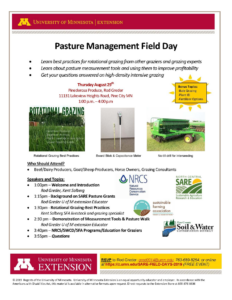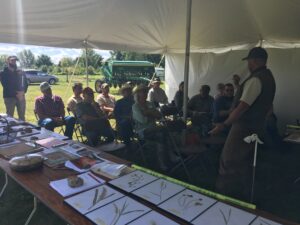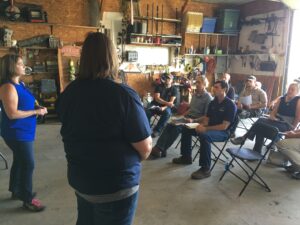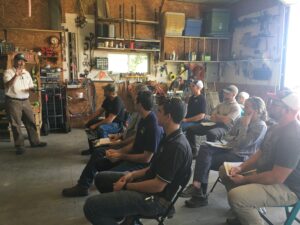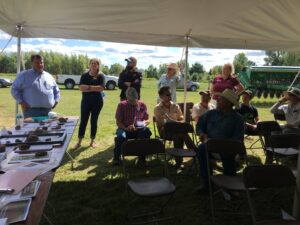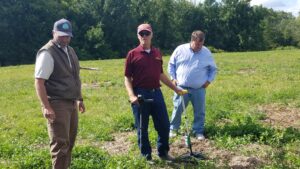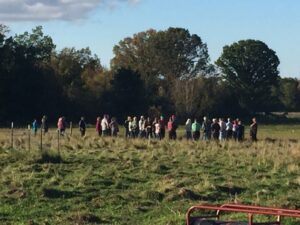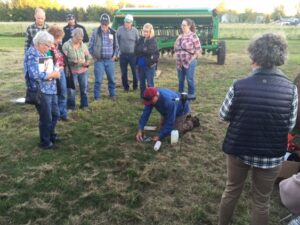Final report for LNC16-379
Project Information
Grass-based animal production systems have proven benefits to soil health and water quality. Animal health and productivity can also be improved in well-managed pasture-based operations. Graziers need reliable, affordable and easy-to-use tools to be able to document productivity benefits that come from adoption of intensive grazing methods and to drive evidence-based decisions. Greater use of these data-driven tools, to replace or complement 'eyeball' and un-validated qualitative assessments, will be an outcome. Better understanding of the tools, and practice with them, will lead to faster adoption of intensive (but sustainable) grazing management practices as hard data supports their use.Various tools exist but many have not been formally evaluated side-by-side to determine repeatability, accuracy, ease of use and complementarity, especially for grazier use, in the North Central Region. We will work with progressive graziers to compare tools for use on the farm, construct an integrated toolkit for use by graziers and educators, develop multi-modal training and disseminate results. The first phase is research-based using replicated trials across 2 locations over years 1 and 2 to compare measurement methods for accurate determination of quantity and quality of forage produced. The second phase will involve on-farm demonstration of the tools at multiple field days in year 3. Numerous forage measurement tools will be compared side-by-side including but not limited to: optical and digital refractometers, manual and electronic rising/falling plate meters, sward height stick, crop sensors, compaction meters, and visual methods (pasture condition scoresheet). These tools will be compared to gold standards, like clipping and weighing forage, by evaluating the following characteristics: accuracy, cost, ease-of-use, repeatability of data, time to conduct, ability to use in making management decisions and correlation to actual forage and animal productivity. A tangible outcome will be development of a PPP (Pasture Productivity Pail) that is an integrated set of tools and methods for graziers to use in making management decisions. This tool can complement the NRCS Soil Health Bucket by extending measurement to above ground forage production. This increased measurement of pasture productivity should lead to greater animal productivity and farmer profitability while maintaining soil and water quality.
Graziers and grazing educators are the end-users of the information generated in the project.
Greater use of these quantitative tools, to replace or complement 'eyeball' and un-validated qualitative assessments, will be an outcome that allows better decision-making.
Better measurement leads to evidence-based decisions about management practices. Better understanding and practice with the tools should lead to faster adoption of intensive highly-managed grazing practices.
Greater use of intensive (but sustainable) grazing management practices will lead to improved productivity and more sustainable economic conditions for grass-based operations.
Permanent, vigorous and diverse ground cover will provide benefits to soil and water.
Cooperators
- (Educator)
- (Educator)
Research
Graziers need reliable, affordable and easy-to-use tools to document productivity benefits from adoption of intensive grazing methods and to drive evidence-based decisions. Many tools, methods and protocols exist but are costly, complicated and not value-added. We plan to compare these approaches so we can recommend a valuable toolkit for north central region graziers.
The experiments are being conducted using replicated trials across 2 plots at 2 locations over years 1 and 2. Year 3 will be used to confirm results and demonstrate and disseminate the findings through public field days.
We are working with grazing consultants, extension forage specialists, graziers and NRCS grazing specialists in Year 1 and 2 in hands-on field plots to determine how to calibrate, demonstrate, explain, and integrate forage measurement tools that can be used to train professionals and graziers on their usage and value. These side-by-side in-field demonstrations will provide great networking and learning that will inform our training materials with robust input from different perspectives. We are comparing the tools to gold standard to check for accuracy. We will select a subset of tools that provide useful and complementary information, based on our joint learning in Years 1 and 2. We will select those accurate tools that are cost-effective and time-efficient that we will will then integrate them into a toolkit (Pasture Productivity Pail-PPP.)
In Year 3 we trained professionals and graziers on the usage of these tools and interpretation of the resulting data. We will generate a program with curriculum explaining the integrated usage of these tools to measure forage productivity and relate it to soil health. The protocol and videos and list of materials and tools will also reside on appropriate agency websites similar to the Soil Health Bucket program.
In year 1 we purchased equipment and supplies, calibrated tools and became familiar with tool usage in the field. We created grazing squares and other tools. We also developed protocols for comparing tools and recording data. We worked with cooperators to identify plot locations and to plan our sampling protocols. We collected forage samples and dried and weighed them to create the gold standard for additional side-by-side measurements. We began to take measurements with rising plate meters and the Grass master to establish sampling procedures to provide reliable data and to determine costs and time to use these tools. Those preliminary measurements were used to plan year 2 replicated trials. We've learned that these more complex tools will likely require significant training that might preclude use by most graziers but could still be useful for educators, agronomists and consultants.
In year 2 we conducted trials on 3 farms and collected data for tools in the study. We sampled 2 plots at each location on 2 different dates. We held one field day in Wright County (Fifteen attendees). Another one in Pine County was cancelled.
In year 3 we repeated the field tests to confirm our conclusions from year 2. We sampled 2 plots at each location on 2 different dates. See conclusions section.
A summary of the comparison of tools based on all factors is here:2018-SARE-Tool-Evaluation-Summary-Quantity-Only
We used this report for our training in 2018 and updated it for training in 2019.
Education
- In year 1 we educated the project team members on the usage of the various tools. The collaborators represent SFA, MGLA, NRCS, UofM and Thousand Hills Cattle Company so they have networks that they reached out to as we progressed on the project.
- Training/Workshops/Field Days – In years 2 and 3 a total of 3 workshops were held on farms of collaborators and key influencers in Minnesota to explain the usage and value of using the quantitative tools being evaluated. We averaged 12-20 attendees for each field day.
- Educational materials – existing video, decision aid (Table 1) and how-to fact sheets on the integrated use of recommended measurement equipment were generated in year 3 and still in development.
- Two webinars are planned for summer of 2020 to reach a broader audience to discuss the project outcomes and our recommendations.
Pre-existing Youtube tutorials on using tools:
Rising Plate Meter
https://www.youtube.com/watch?v=5nJcwJZr9ro
Grazing Stick
https://eorganic.org/node/5395
Grassmaster Pro Capacitance Meter
https://www.youtube.com/watch?v=5VUj_0mK-98&feature=youtu.be
Project Activities
Educational & Outreach Activities
Participation Summary:
Pasture walks and discussions with the project team members were done in year 1
We held one field day in Wright County in Year 2. There were 15 attendees. Two field days and pasture walks in 2019.
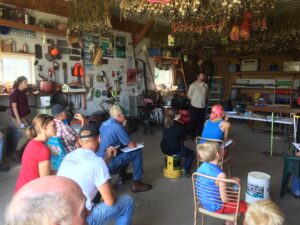
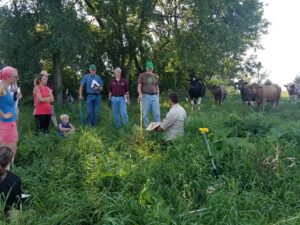
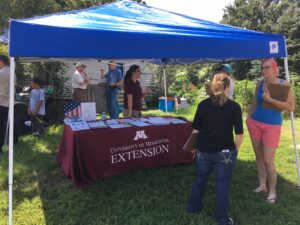
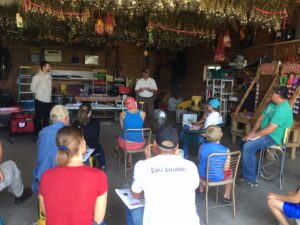
2 field days were held in 2019. 10-12 attended in Howard Lake. 20 attended in Pine City
The attendance lists are below. Feel free to contact any attendees for feedback and learnings.
A journal article is also being written for publication in 2020.
2 webinars are planned for summer of 2020 with SARE and SFA. Another field day is planned in Pine County to disseminate the results
Learning Outcomes
- Understanding of the potential tools available for measuring pasture productivity
- Understanding of the importance of compaction, soil temperature, soil moisture on soil health and resulting pasture productivity
- Understanding the true value of intensive rotational grazing on soil health, pasture productivity and animal productivity and health
- Understanding the need for on-the-ground expertise in weed ID, grass and legume ID, density estimation etc.
Project Outcomes
Use of grazing sticks and pasture condition scoring sheets to estimate pasture productivity.
As a result of focusing on pasture growth in this study I looked at what management practices could result in greater productivity. Most long-time graziers recommend more frequent moves as one of the most effective practices to stimulate soil health and result in greater grass productivity. One of the challenges to making more frequent moves is the transporting of water, mineral, back rub etc equipment from paddock to paddock. I recognized a need to address that challenge with a a mobile unit that contains all this equipment and can easily be moved. I was granted a farmer-rancher grant in 2019 to design and test a mobile station prototype that is underway through 2020.
As a result of our field trials and based on the factors listed in Table 1 we conclude the use of a calibrated sward stick, also called grazing stick, as a quantitative measure, but indirect, combined with the pasture condition score sheet (USDA, NRCS) plus education on the use of both tools can provide graziers the level of information they need to forecast short-term yields while also anticipating sustainability of production over a season or multiple seasons.
The use of rising and falling plate meters and the capacitance meters can provide more detailed information on the amount of forage in a paddock. However, the calibration needed to accurately predict forage mass in highly diverse stands of mixed forage is a large challenge and the predictive benefit of estimates from these tools does not warrant the time and expertise needed. The cost of these tools ($1000-2000) also is a limiting factor especially for smaller graziers and the increased accuracy may not be warrant that cost.
As a result of our trials and our in-pasture training we observed that use of the grazing stick in conjunction with completing the pasture condition scoring sheet and guidelines (USDA-NRCS) gave graziers adequate information and provided enough expertise to begin to accurately estimate short-term forage production as well as estimates of longer-term productivity in lieu of the more expensive and complex tools. (See Table 1)
Our original concept of a Pasture Productivity Pail is projected to contain - (1) the grazing stick, (2) pasture condition score sheet/guide to pasture condition scoring, (3) soil thermometer, (4) soil compaction meter (optional), (5) pasture grasses and legumes identification sheet, (6) soil test bags and instructions, (7) pasture weed ID chart (ID Weeds app), (8) photo gallery of legume content, (9) NRCS grazing record-keeping chart (or electronic record-keeping app like Pasture Map) and (10) clipboard and pencil.
